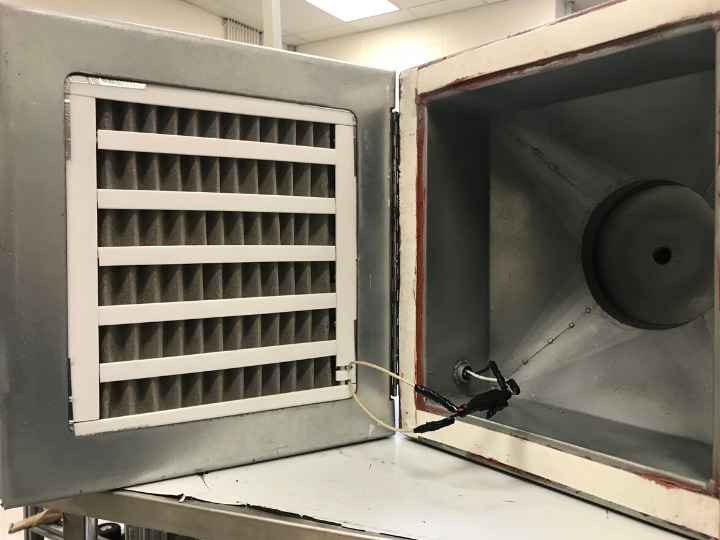Jul 8 2020
A research team at the University of Houston (UH) collaborated with their colleagues to design a “catch and kill” air filter that has the ability to trap the virus that causes COVID-19 and kills it immediately.
 Researchers from the University of Houston, in collaboration with others, have designed a “catch and kill” air filter that can trap the virus responsible for COVID-19, killing it instantly. Image Credit: University of Houston.
Researchers from the University of Houston, in collaboration with others, have designed a “catch and kill” air filter that can trap the virus responsible for COVID-19, killing it instantly. Image Credit: University of Houston.
Zhifeng Ren, who is the director of the Texas Center for Superconductivity at UH, worked with Monzer Hourani, CEO of Medistar—a Houston-based medical real estate development firm—and other scientists to develop the filter, which has been reported in a paper recently published in Materials Today Physics.
According to the team, virus tests carried out at the Galveston National Laboratory identified 99.8% of the novel SARS-CoV-2, the virus that is responsible for causing COVID-19, was destroyed in a single pass via a filter created from commercially available nickel foam that was heated to 200 °C, or around 392 °F.
It also killed 99.9% of the anthrax spores during tests performed at the national lab, which is operated by the University of Texas Medical Branch.
This filter could be useful in airports and in airplanes, in office buildings, schools and cruise ships to stop the spread of COVID-19. Its ability to help control the spread of the virus could be very useful for society.
Zhifeng Ren, MD, Study Co-Corresponding Author and Anderson Chair Professor of Physics, University of Houston
According to Ren, the executives of Medistar are also developing a desktop model that can purify the air in an office worker’s closest surroundings.
He stated that Medistar contacted the Texas Center for Superconductivity at the University of Houston (TcSUH) on March 31st, 2020, as the pandemic was spreading all over the United States, seeking support for advancing the idea of a virus-trapping air filter.
The co-first authors of the paper are Luo Yu from the UH Department of Physics and TcSUH, together with Dr Garrett K. Peel of Medistar and Dr Faisal Cheema from the UH College of Medicine.
The team was aware of the fact that the virus can stay in the air for around three hours, implying a filter that could eliminate it rapidly was a practical plan. Since the businesses are about to reopen, it was crucial to control the spread of the virus in air-conditioned spaces.
Furthermore, Medistar knew the virus is not capable of surviving temperatures above 70 °C, and around 158 °F. Therefore, the team decided to use a heated filter. Since the filter temperature was far hotter—around 200 °C—they could kill the virus almost immediately.
Ren recommended the use of nickel foam as it satisfied various essential needs: it is flexible, enables airflow, and is porous and electrically conductive, making it easy to heat.
However, nickel foam has low resistivity, making it harder to increase it to a sufficient temperature that would rapidly kill the virus. The team resolved that issue by folding the foam and linking several compartments with electrical wires to raise the resistance and increase the temperature to as high as 250 °C.
Electrically heating the filter, instead of heating it using an external source, reduced the amount of heat that escaped from the filter, enabling air conditioning to operate with minimum strain.
A prototype of the filter was developed by a local workshop and was initially tested at Ren’s laboratory for the relationship between current/voltage and temperature. It was then tested at Galveston laboratory for its ability to destroy the virus.
According to Ren, it meets the need for traditional ventilation, heating, and air conditioning (HVAC) systems.
This novel biodefense indoor air protection technology offers the first-in-line prevention against environmentally mediated transmission of airborne SARS-CoV-2 and will be on the forefront of technologies available to combat the current pandemic and any future airborne biothreats in indoor environments.
Dr Faisal Cheema, Study Co-First Author, College of Medicine, University of Houston
Hourani and Peel have recommended a phased rollout of the device, “initiating with high-priority venues, where essential workers are at high risk of exposure (such as hospitals, schools, and health care facilities, as well as public transit environs like airplanes).”
They stated that both will enhance safety for frontline workers in essential sectors and enable non-essential workers to resume their work at public workspaces.
Journal Reference:
Garrett, L. Y., et al. (2020) Catching and killing of airborne SARS-CoV-2 to control spread of COVID-19 by a heated air disinfection system. Materials Today Physics. doi.org/10.1016/j.mtphys.2020.100249.